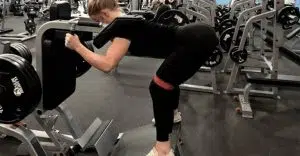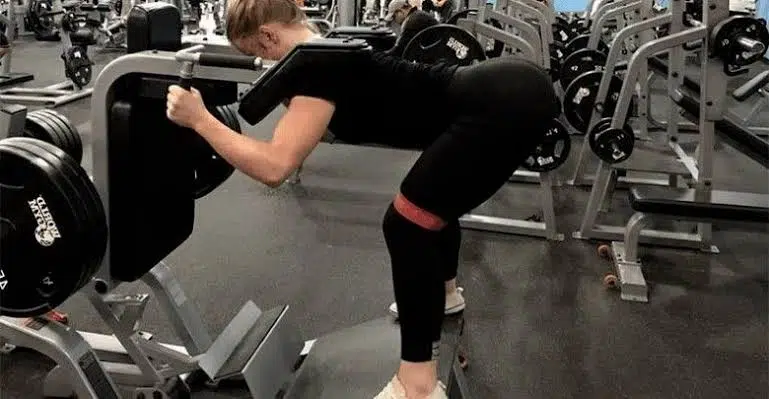The reverse hack squat is an exercise used to help strengthen the back of your thigh, commonly known as the hamstrings.
It’s also great for strengthening your lower back and helping you maintain proper form during squats and leg presses.
This exercise can be performed with or without equipment, depending on your goals and experience level, and it can be done in either a standing or seated position.
Here’s what you need to know about this beneficial exercise.
PEOPLE ALSO READ: Leg and Shoulder Workout To Boast Yourself – Top 10 Workouts(Opens in a new browser tab)
Benefits of Reverse Hack Squats
The reverse hack squat may look like an ordinary hack squat, but they’re actually very different.
Whereas a traditional hack squat works your glutes and quadriceps primarily, a reverse hack squat works your lower back, glutes, and hamstrings more.

This can make them one of the most effective exercises you can do to build strong legs and improve stability while lifting.
As they engage more muscles at once than their traditional counterparts, they also significantly improve coordination—making it easier to lift bigger weights without sacrificing form.
And because they involve both concentric and eccentric movements, they’ll help increase your explosive power.
5 Benefits of Reverse hack squat
1. It works on your legs, shoulders, and chest.
2. It’s performed without any equipment. It can be performed anywhere.
3. It has two phases: The concentric (negative) portion of the movement and a concentric (positive) portion of the movement.
4. During the negative part, your hips will bend at an angle of 120 degrees in relation to your knees, and then during the positive phase, your hips will move up towards 90 degrees in relation to your knees.
5. And finally it helps you get more flexible.
A reverse hack squat is one of those exercises that are very easy to perform but have many benefits for your body if done correctly.
It focuses on strengthening all muscles around the thighs and buttocks as well as improving flexibility in hip joints.
It may not seem like much, but it makes a big difference once you learn how to do it properly with good form.
If you want to add some spice to your workout routine or just want something new then give these squats a try because they are going to help you out big time.
The best thing about them is that they don’t require any equipment so you can perform them anywhere!
How to Do Reverse Hack Squats
The reverse hack squat isn’t just one of those exercises you do because it sounds cool.
It’s actually one of my favorite lower-body movements for developing strength and stability in the lower back, glutes, hamstrings, and quads.
Doing reverse hack squats allows me to include both multi-joint and single-joint moves into my routines for an all-around leg workout.
So here’s how to do them correctly.
In order to perform these properly, get into a standing position with your legs shoulder-width apart.
This will be your starting position. From here, slowly bend forward at your waist until you have almost reached 90 degrees of knee flexion (this means almost but not quite touching your thighs with your hands).
Your back should remain straight and flat as if you were about to sit on a chair behind you.
Hold for a second or two in that position then come back up to starting position.
That’s one rep. Repeat for 10-12 reps. You can also increase or decrease the amount of weight used by holding dumbbells in each hand while performing reverse hack squats.
Proper Form for Reverse Hack Squats
When you’re ready to perform your reverse hack squat, make sure that you start in an upright position with your feet planted firmly on the ground.
You should make sure that your lower back stays parallel to your knees and that there is no bending of your hips.
Once you have achieved proper form, bend forward slightly as if you are about to pick up something from off of the floor and move into an upright position again.
Repeat for 8-10 reps before moving onto 10-12 reps using a lighter weight or resting for 30 seconds before repeating until failure.
Now that you know how to do reverse hack squats, why not try them out in one of our new workout routines! One thing’s for sure: they’ll definitely leave you sore.
Common Mistakes
When performing reverse hack squats, you may have noticed that your knees tend to shift forward and your heels often come off of the ground.
In other words, it can be difficult to keep proper form. This happens for two reasons: one, you are using weights that are too heavy; and two, you’re not engaging your core enough.
One or both of these factors will ultimately cause poor form on reverse hack squats.
If you want to prevent knee pain and injury, make sure that you use lighter weights and focus on engaging your core throughout each repetition.
You should also make sure that your knees don’t extend beyond your toes when doing reverse hack squats—instead, they should remain behind them at all times.
To ensure proper form during each rep, check out some images online of people doing reverse hack squats with perfect form.
You can also ask a trainer at your gym if they could watch you do them so they could give feedback on how to improve your technique.
Once you know what good form looks like, try practicing with lighter weights until you get it right!
Safety Precautions
Reverse hack squats are not for everyone, especially if you have any knee issues.
First and foremost, make sure you don’t round your back when doing these or let your hips dip below your knees.
Rounding your back and dipping below your knees can put an excessive amount of stress on your spine, causing disc injuries or pinching nerves.
You can also tweak things like the sciatic nerve by focusing on proper form. If you feel pain in any of these areas after doing reverse hack squats, it may be best to avoid them until you get checked out by a doctor or physical therapist (as appropriate).
Finally, if you do decide to try these, just remember that they should only be done as part of a full-body workout program that includes plenty of flexibility work.
Also, keep in mind that you shouldn’t go all-out on every rep; reverse hack squats should always be done with strict form and should never leave you feeling sore afterward.
Be smart about how much weight you use as well—if possible start with just body weight until you get used to them—and remember that they shouldn’t take up more than one set at most.
Even then, adding too much weight too quickly will probably cause problems down the road instead of getting rid of them.
